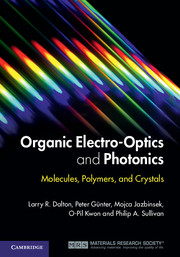Book contents
- Frontmatter
- Dedication
- Contents
- 1 Introduction
- 2 Nonlinear optical effects
- 3 Electro-optic effects
- 4 Molecular nonlinear optics
- 5 Acentric self-assembled films
- 6 Crystalline materials
- 7 Electrically poled organic materials and thermo-optic materials
- 8 Overview of applications
- 9 Organic electro-optic waveguides, switches, and modulators
- 10 Nonlinear optical infrared and terahertz frequency conversion
- 11 Photorefractive effect and materials
- 12 Conclusions and future prospects
- Index
12 - Conclusions and future prospects
Published online by Cambridge University Press: 05 August 2015
- Frontmatter
- Dedication
- Contents
- 1 Introduction
- 2 Nonlinear optical effects
- 3 Electro-optic effects
- 4 Molecular nonlinear optics
- 5 Acentric self-assembled films
- 6 Crystalline materials
- 7 Electrically poled organic materials and thermo-optic materials
- 8 Overview of applications
- 9 Organic electro-optic waveguides, switches, and modulators
- 10 Nonlinear optical infrared and terahertz frequency conversion
- 11 Photorefractive effect and materials
- 12 Conclusions and future prospects
- Index
Summary
General conclusions
In the preceding chapters, an introduction has been provided into the fundamentals and state-of-the-art of organic nonlinear optical materials and devices with particular emphasis on electro-optic, second-harmonic generation, difference-frequency generation, optical rectification, and photorefractive materials, devices, and applications related to organic second-order nonlinear optical materials. Organic electro-optic materials exhibit extremely attractive features with respect to temporal response to time-varying electric fields and with respect to the magnitude of second-order optical nonlinearity, which can translate into energy-efficient devices. Organic materials also are attractive in providing a wide variety of processing options including crystal growth (from solution, melt, and vapor phase), sequential synthesis/self-assembly (both Langmuir–Blodgett and Merrifield methods), electric field poling of macromolecular materials near their glass transition temperature, and even laser-assisted electric field poling. Organic materials are amendable to nano-imprint lithography, leading to stamping out complex circuitry, and they are amenable to lift-off techniques for production of conformal and flexible devices. Organic second-order nonlinear optical materials are compatible with a wide variety of materials including semiconductors, metal oxides, and metals; this feature greatly facilitates the production of hybrid devices including those based on silicon photonics, plasmonics, photonic crystals, and metamaterials. They have been integrated into stripline and resonant device structures, cascaded prism device structures, and even structures for slow wave propagation. The low dielectric constants of organic electro-optic materials can also be an advantage for certain applications such as sensing.
Of course, there is a great diversity of organic nonlinear optical materials with a corresponding diversity of properties. However, organic second-order nonlinear optical materials do not typically possess the extremely low optical loss and high optical damage threshold of crystalline inorganic materials. Nevertheless, they frequently exhibit lower optical loss than inorganic electro-absorptive materials and much higher dielectric breakdown properties than semiconductor materials.
The performance properties of organic nonlinear optical materials continue to evolve at a significant rate. However, the commercialization of organic nonlinear optical materials is very limited and immature relative to inorganic materials, and thus the cost of devices based on organic materials does not benefit from large-scale production. Moreover, device engineering utilizing organic nonlinear optical materials is relatively immature compared with the device engineering focused on inorganic materials.
- Type
- Chapter
- Information
- Organic Electro-Optics and PhotonicsMolecules, Polymers and Crystals, pp. 282 - 286Publisher: Cambridge University PressPrint publication year: 2015



